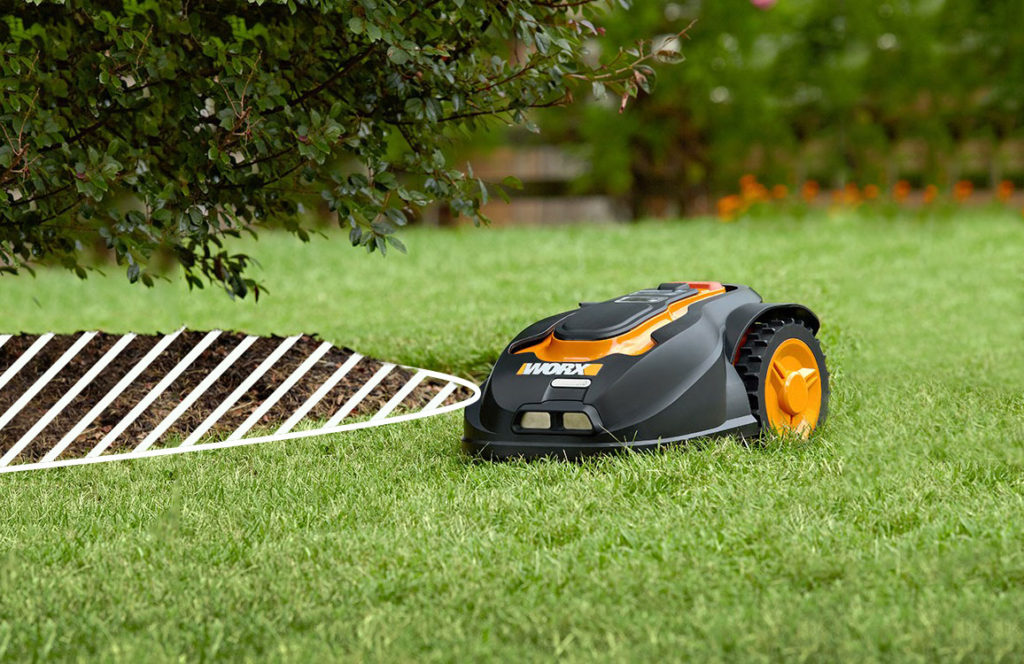Robotic mowers mow away everything within their working area that gets under their wheels and can be cut with their sharp blades. But what if you want to exclude certain areas of your yard? For this purpose, there is the nifty option of creating islands of excluded lawn area with the boundary wire.
How can off-limits islands be created with the boundary wire? Islands can be created with the boundary wire by leading the boundary wire from its outer course around the lawn to the island, around the island and back again parallel to the running wire. To create islands after the initial laying of the boundary wire, cable branches with cable clamps can be added.
In the next sections I will show you exactly how to create an island and what other options are available. For example, it is also possible to connect islands, or to create so-called pseudo-islands, which are needed in certain situations.
Contents
Why Would You Create an Island?
Before we come to the mooring of the island, we should perhaps ask ourselves once again the question of when and why an island makes sense at all. Basically, you can use islands to exclude certain areas in your lawn from the mower’s path. These can be:
I’m sure you can think of other instances where you might need to create an island for your robotic mower to avoid. In these cases, is it necessary and sensible to create an island?
Fixed Obstacles Like Trees
With solid objects such as trees or sheds, you could simply rely on the mowing robot’s shock sensor. It bumps into it, notices that it has driven into an obstacle, and turns around.
This method works, but the shock sensor is then being routinely and frequently stressed. If the robotic mower runs into trees 1,000 times a day, this could end up reducing the life of the shock sensor over time. If you don’t have a bumper on the mowing robot, this will also cause many scratches on the device.
The main problem with this approach, however, is that the robotic mower takes longer to mow if it is constantly bumping into things. When it bumps into an obstacle, it will take a little longer to find a new path than if it hits the boundary wire. This makes the robot more inefficient when mowing.
This also increases the risk of the mowing robot getting stuck on the obstacles. For example, trees can have protruding roots on which the mowing robot can become hung up. It is therefore also sensible to exclude trees from your robot’s accessible path, even if it is not absolutely necessary.
Garden Beds, Flowerbeds, and Grassy Islands
If you don’t want to build a physical barrier around your flower beds or any other section you wish to cordon off from your robotic mower, turning these areas into islands using the boundary wire is a perfect alternative. It doesn’t always look so aesthetically pleasing if every section of flowers in your yard has to be fenced or walled off from the rest of the lawn, so islands are perfect for avoiding this.
Ground Level Pools and Ponds
Of course it makes sense to create an island here as well, if you do not want your robotic mower to go for a swim. In this case, however, the potential for a rare glitch or failure in the boundary wire, allowing the robot to overshoot it, is much more serious.
Here it can actually be quite useful to construct a physical barrier in addition to creating an island around it with the boundary wire. This way the robotic mower does not constantly run into the barrier, but in the case that it does accidentally cross the boundary wire, it will then hit the barrier rather than fall into the pool.
How to Make an Island with the Boundary Wire
Creating an island with the boundary wire is not that difficult. A cable is branched off from the main boundary wire, routed around the desired area, and returned parallel to the incoming cable branch. The connection between the island and the boundary wire is not perceived as a boundary by the mowing robot.
Most of the time it makes sense to choose the shortest route between the island and the boundary wire and to lay the connection here. But there may also be reasons why you do not want to lay it here. For example, the guide wire could already be running right where you want to route the barrier wire to your island..
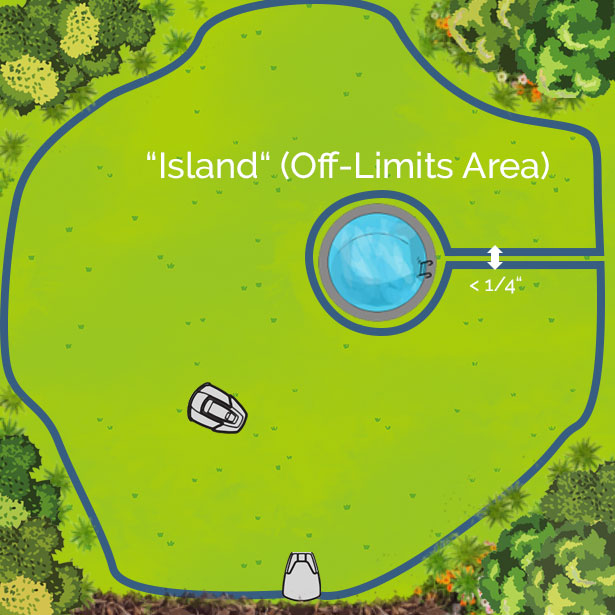
The operating instructions always state that the guide wire should not cross the boundary wire. In practice, however, it has been shown many times that this is indeed possible if the cables cross each other at a right angle. You would have to test this in each individual case. You can also opt to avoid it directly.
In the following I describe how you can create an island afterwards, i.e. when your boundary wire is already installed. You can, of course, also create your island during the original installation, where you can lead the cable directly around the island without having to cut it.
Creating an Island with the Boundary Wire
Now if you are sure where you want to moor the island, proceed as follows:
- Cut the boundary wire that surrounds your garden at the point where you want to have your island branch off (if the cable is underground, dig it out first)
- Use a cable connector to connect the island cable to the boundary wire
- Lead the cable in a direct line to the island
- Run the cable around the island and keep the usual distances required your that type of island/barrier.
- Guide the cable back parallel to the running cable
- The distance between the two cables must be as small as possible (< 1 cm)
- Make sure not to cross the returning cable with the side of the cut cable that provides the initial route towards the island.
- Now connect the end of the cable to the other loose end of the boundary wire where you cut it
Whether you lay the cable underground at the end is up to you. It will also work aboveground, and will be no longer visible after 4 to 6 weeks because the surrounding lawn will grow over it. If you scarify your garden, however, it is advisable to lay it far enough underground to prevent damage. For testing purposes, it makes sense to lay the cable above ground first.
The principle behind it is the following: As you may know, the boundary wire generates a magnetic field with which the mowing robot can register due to its sensors. At the point where the boundary wire runs back and forth parallel to the island, the two magnetic fields of the back and forth running cable cancel each other out, so that the cable is virtually invisible to the mowing robot at this point.
This allows the mower to access the area of lawn between the island and the outer boundary wire without getting stopped by the wire that is routed to the island. See also my article on how the boundary wire works.
Regarding point 7: To be more precise, when the cable crosses over, the number of crossings must be even. The cable of the respective side must, so to speak, come out at the island on the side on which it came in at the junction. Have a look at the following diagram, which will more clearly illustrate this concept.
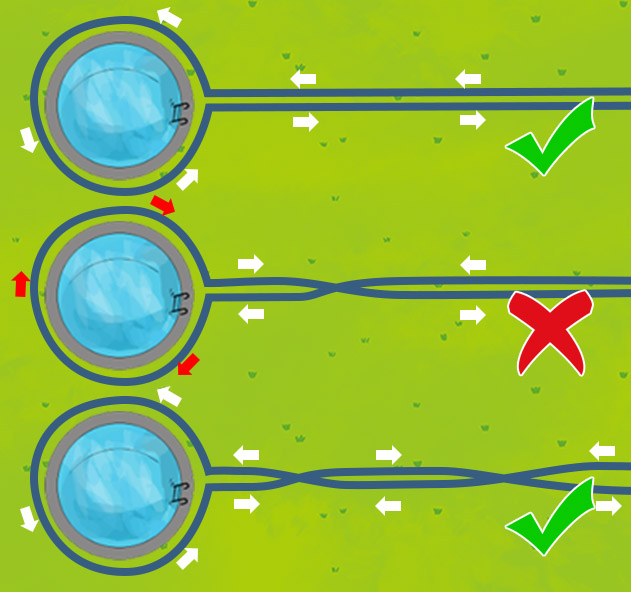
Linking Islands with the Boundary Wire
It is also possible to easily link several islands together. To do this, simply run the boundary wire from one island to the next using the same principle. Have a look at the following graphic to get an idea how this works.
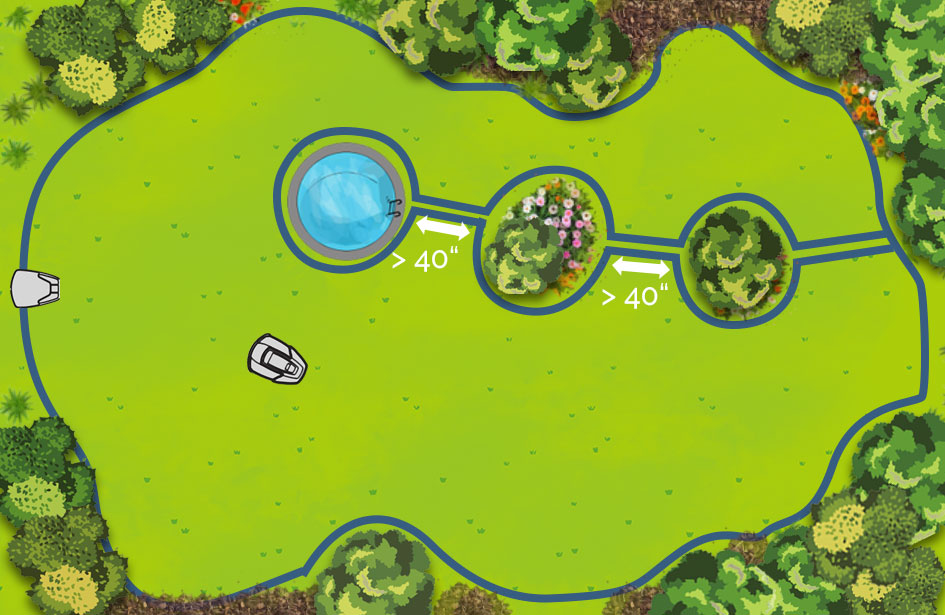
Creating a Pseudo Island
Sometimes you don’t want to create an island, you want to create a pseudo-island. In principle this is a peninsula, because the mowing robot cannot cross the connection between the outer boundary wire and the island. In this case, the cable running back and forth to the island is laid so far apart that the magnetic fields do not cancel each other out.
8 inches is usually a good distance here, as the robotic mower can often still mow the lawn on the connecting strip.
In this graphic, I show you once again how the pseudo island is created. Basically, you proceed in the same way as you would for a regular islan, except that you intentionally put the outgoing and incoming running cable further apart.
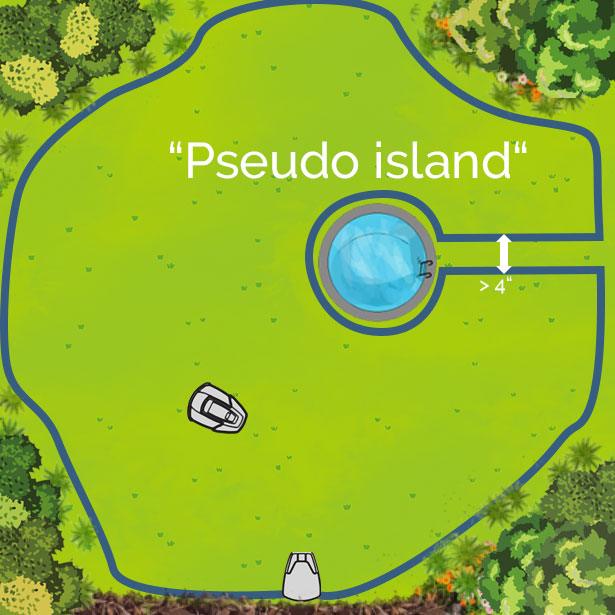
When Do You Need a Pseudo Island?
- The island is extremely large and covers more than 30 yards
- The island has a very complex shape, so the mowing robot would not recognize a real island
- For other unexplained reasons a real island does not work
- You want to install a charging station on the island for a mowing robot without a guide wire (it then finds its way to the charging station via the boundary wire)
- You want to use the edging function of your robotic mower on the island
Related Questions
How large must the distance between islands be for robotic mowers? For most mowing robot models, the distance between islands that are excluded with the boundary wire must be at least 1 meter.How large must the distance between an island and the boundary wire be? The distance between an island created with the boundary wire and the boundary wire running around the outside should be at least 1 meter for most mowing robot models.
08/20/2020
Recent Content
Are you looking to buy a robotic lawn mower? I think there has never been a better time, since the most recent models on the market are actually quite sophisticated so that it can now be appealing...
High-end robotic lawnmowers can be a significant investment, so I was curious about how often they get stolen and did some research on the topic. Although there is no specific data available on...

